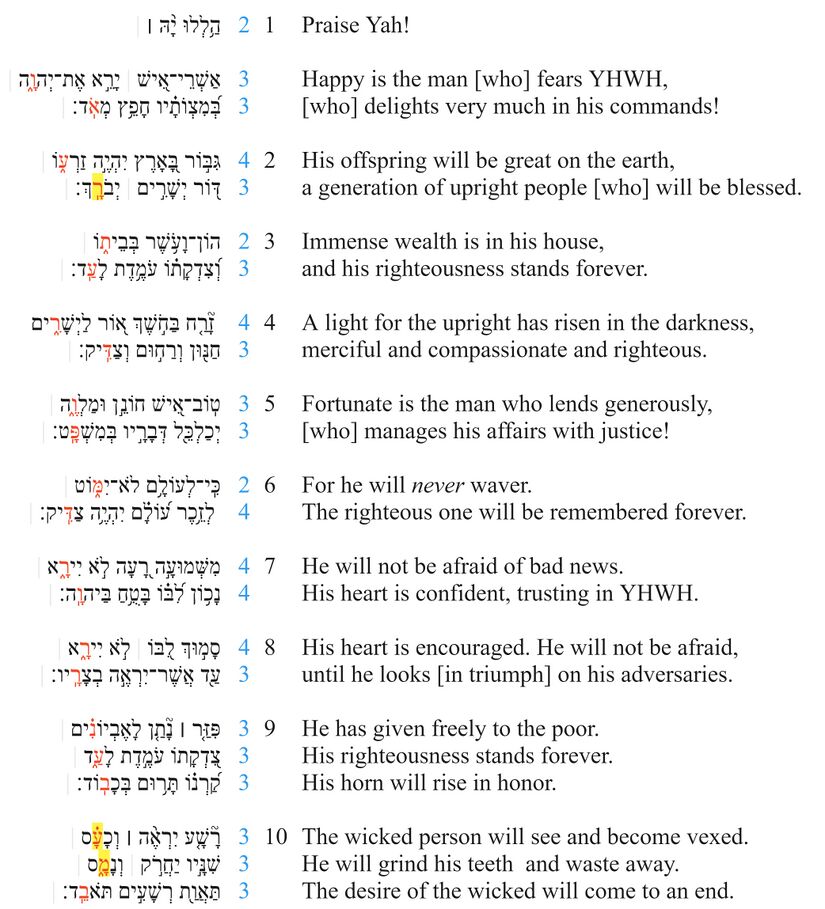Psalm 112 Poetic Structure
Poetic Structure
In poetic structure, we analyse the structure of the psalm beginning at the most basic level of the structure: the line (also known as the “colon” or “hemistich”). Then, based on the perception of patterned similarities (and on the assumption that the whole psalm is structured hierarchically), we argue for the grouping of lines into verses, verses into sub-sections, sub-sections into larger sections, etc. Because patterned similarities might be of various kinds (syntactic, semantic, pragmatic, sonic) the analysis of poetic structure draws on all of the previous layers (especially the Discourse layer).
Poetic Macro-structure
If an emendation or revocalization is preferred, that emendation or revocalization will be marked in the Hebrew text of all the visuals.
| Emendations/Revocalizations legend | |
|---|---|
| *Emended text* | Emended text, text in which the consonants differ from the consonants of the Masoretic text, is indicated by blue asterisks on either side of the emendation. |
| *Revocalized text* | Revocalized text, text in which only the vowels differ from the vowels of the Masoretic text, is indicated by purple asterisks on either side of the revocalization. |
Notes
- vv. 1–4 // vv. 5–10. The psalm divides into two main section (vv. 1–4 // vv. 5–10). This division is signaled most clearly by the similar beginnings of each section. Not only are the phrases אַשְׁרֵי־אִ֭ישׁ and טֽוֹב־אִ֭ישׁ remarkably similar, but they are also followed by semantically related prepositional phrases (בְּ֝מִצְוֺתָ֗יו // בְּמִשְׁפָּֽט) and verses that talk about the future and use the verb יִהְיֶה.[1]
- The first section (vv. 1–4) is further bound by the repetition of the word יְשָׁרִים (vv. 2b, 4a).
- Each of these sections is further divided into two–verse units.[2]
- vv. 1–2. The first unit is bound by an inclusio: the words אשרי and ברך, which belong to the same semantic domain of "praising/blessing" and are sometimes even used as synonyms (compare e.g., אשרי האיש in Ps. 1:1 with ברוך הגבר in Jer. 17:7).
- vv. 3–4. The second unit is bound by the repetition of the root צדק. The beginning and the ending of this unit are echoed in the beginning and ending of other units as well (v. 3 // v. 9; v. 4b // v. 6b).
- vv. 5–6. The boundaries of the first unit in the second main section of the psalm are clearly defined syntactically; the כי clause in v. 6 grounds the statement in v. 5.
- vv. 7–8. The unit consisting of vv. 7–8 is bound together by a chiasm
a. "bad news" b. "he will not be afraid" c. "his heart is confident" d. "trusting in YHWH" c.' "his heart is encouraged" b.' "he will not be afraid" a.' "adversaries"
- vv. 9–10. The verses in this unit are the only two tricola in the psalm. They also have similar sounding endings: כבוד and תאבד.
Line Divisions
Line division divides the poem into lines and line groupings. We determine line divisions based on a combination of external evidence (Masoretic accents, pausal forms, manuscripts) and internal evidence (syntax, prosodic word counting and patterned relation to other lines). Moreover, we indicate line-groupings by using additional spacing.
When line divisions are uncertain, we consult some of the many psalms manuscripts which lay out the text in lines. Then, if a division attested in one of these manuscripts/versions influences our decision to divide the text at a certain point, we place a green symbol (G, DSS, or MT) to the left of the line in question.
| Poetic line division legend | |
|---|---|
| Pausal form | Pausal forms are highlighted in yellow. |
| Accent which typically corresponds to line division | Accents which typically correspond to line divisions are indicated by red text. |
| | | Clause boundaries are indicated by a light gray vertical line in between clauses. |
| G | Line divisions that follow Greek manuscripts are indicated by a bold green G. |
| DSS | Line divisions that follow the Dead Sea Scrolls are indicated by a bold green DSS. |
| M | Line divisions that follow Masoretic manuscripts are indicated by a bold green M. |
| Number of prosodic words | The number of prosodic words are indicated in blue text. |
| Prosodic words greater than 5 | The number of prosodic words if greater than 5 is indicated by bold blue text. |
If an emendation or revocalization is preferred, that emendation or revocalization will be marked in the Hebrew text of all the visuals.
| Emendations/Revocalizations legend | |
|---|---|
| *Emended text* | Emended text, text in which the consonants differ from the consonants of the Masoretic text, is indicated by blue asterisks on either side of the emendation. |
| *Revocalized text* | Revocalized text, text in which only the vowels differ from the vowels of the Masoretic text, is indicated by purple asterisks on either side of the revocalization. |



